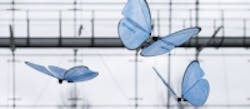Vision system helps bionic butterflies coordinate flying
Festo, a global company in automation, technical training, and development, recently demonstrated its eMotionButterflies project, which shows how several autonomous flying objects can move independently in an enclosed space without colliding.
eMotionButterflies was developed as research for technologies, applications, and solutions in the production of the future. Festo notes that the integrated technologies and the networked overall system are, in principle, possible solutions for future industrial logistics applications. In order to coordinate flying for the butterflies and make it so they don’t crash into each other, Festo utilized indoor GPS and an infrared camera-based vision system.
Ten near infrared cameraswere installed in the room to record the butterflies, which were equipped with infrared markers. The cameras used were GS3-U3-41C6NIR-C cameras from Point Grey. These cameras feature a 4.1 MPixel near-infrared CMOSIS CMV4000-3E12 CMOS image sensor, which features a 5.5 µm pixel size and can reach a frame rate of 90 fps in full resolution. Used with these cameras were BN850 near-infrared bandpass filters from Midwest Optical Systems. These filters block unwanted ambient light while only passing the signal from 850 nm IR LEDs to the cameras.
The cameras transmitted position data to a central master computer, which coordinates the butterflies from the outside, acting like an "air traffic controller." The intelligent networking system creates a guidance and monitoring system, which Festo suggested could be used in the networking factory of the future.
View more information on the eMotionButterflies project.
Share your vision-related news by contacting James Carroll, Senior Web Editor, Vision Systems Design
To receive news like this in your inbox, click here.
Join our LinkedIn group | Like us on Facebook | Follow us on Twitter
Learn more: search the Vision Systems Design Buyer's Guide for companies, new products, press releases, and videos
About the Author

James Carroll
Former VSD Editor James Carroll joined the team 2013. Carroll covered machine vision and imaging from numerous angles, including application stories, industry news, market updates, and new products. In addition to writing and editing articles, Carroll managed the Innovators Awards program and webcasts.
